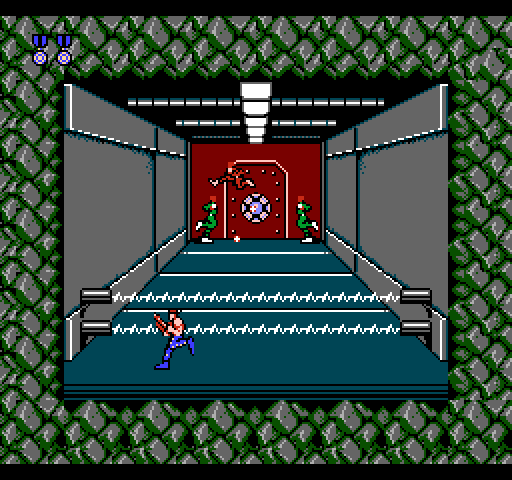Static Base Enemies
The enemies in the pseudo-3D “base” levels in Contra are spawned by a slightly different system compared to the other kinds of levels. Base levels are also divided up into screens, and each screen also gets its own list of enemies that it needs to spawn, but the details of the list are different.

The screens in the base levels do not scroll, so each enemy in the screen enemy list is spawned the moment you enter the screen. Each enemy list starts off with a count of how many targets need to be destroyed on that screen in order to lower the electric barrier and allow you to move forward. The game actually has a bit of unused logic to lower the barrier right away if there are no targets even though there are no screens in the final game that are set up this way. The rest of the enemy list consists of a series of records for each enemy that needs to be spawned. The first piece of data in each record gives the X and Y position for where the enemy should spawn on screen. The second piece of data in each record gives the enemy type to spawn, and the third and final piece is an opaque creation context value just like the one in the enemy lists for the other kinds of levels.
At the moment that you enter a new screen, all of the enemies on that screen’s enemy list are spawned and the list is never referenced again. These enemies are mostly just the stationary things on the back wall like the targets and guns that shoot at you. All of the other enemies that run onto the screen while you’re playing are not spawned through the screen’s enemy list. Instead, they are handled by a different system.
Sequenced Base Enemies
One type of object that is a part of the enemy list for every screen in a base level isn’t actually a visible enemy, but an entity whose job it is to manage all of the enemies that run in from the sides of the screen as you play. This spawner entity processes its own completely separate enemy list for each screen that tells it which enemies to spawn and when. These enemy lists also contain a series of records, one for each enemy that needs to be spawned. The first piece of data in each record determines which kind of enemy to spawn and gives the creation context value for that enemy. The second piece of data gives a delay time to wait before spawning the next enemy. There is also a flag associated with each record that tells if that record is the final one for that screen. Once the final record has been processed, the spawner entity loops back to the first record and begins repeating the same pattern of enemies over and over. Once the whole pattern has been run through 7 times on a single screen, the spawner entity destroys itself so no more enemies will be spawned. This is what triggers the targets on the walls to begin shooting bullets at the player.
Power-up Enemies
On some of the screens in base levels you encounter a red jumping enemy that gives you a power-up when killed. The appearance of these enemies is mostly just specified by the secondary enemy list that the enemy spawner follows, but with the additional rules that only 1 of these red enemies can spawn on any given screen, and you can not spawn a red enemy during the first pass through the secondary enemy list. The creation context data for the jumping enemy in the spawner’s enemy list determines whether or not it can be one that carries a power-up, and if so, what kind of power-up it will drop when killed by the player. The 1 enemy per screen rule applies to spawning the enemy, not killing it, so if you miss the red enemy the first time you won’t get another one again on that screen.
(Prev – This is part 4 of a 7 part series – Next)
Tags: Allan Blomquist, Retro Game, Retro Game Internals, Tomorrow Corporation





Interesting. Do you see any advantage that having the special “spawn-enemy” entity would have in those levels, aside from just simplifying the main update loop or something like that? I guess my first instinct as a programmer would be to just brute-force spawn everything in that particular level.
yeah, why they chose to make the thing that spawns sequenced enemies in the base levels part of the game’s entity system but the thing that spawns the random enemies in the other levels just a function call from the main loop i don’t know. there doesn’t seem to be any major reason to do it one way or the other, maybe it was just written by 2 different people who solved it 2 different ways. making it data driven though is definitely a win over hard coding all the spawns because it’s much more compact when you consider the total amount of code + data you need and probably easier to author (however they authored this stuff…)
That makes sense.
EGP 2014
Could you please help as I am no longer able to play little inferno, it’s not working on my ipad, have deleted the app and added again but still same problem , thank you